Related Research Articles

Grafton is a town in Worcester County, Massachusetts, United States. The population was 19,664 as of the 2020 census. Incorporated in 1735, Grafton is the home of a Nipmuc village known as Hassanamisco Reservation, the Willard House and Clock Museum, Community Harvest Project, and the Tufts University Cummings School of Veterinary Medicine. Grafton consists of the North Grafton, Grafton, and South Grafton geographic areas, each with a separate ZIP Code. Grafton also operates the state's largest On-Call Fire Department, with 74 members.

Mendon is a town in Worcester County, Massachusetts, United States. The population was 6,228 at the 2020 census. Mendon is part of the Blackstone River Valley National Heritage Corridor, an early center of the industrial revolution in the United States. Mendon celebrated its 350th Anniversary on May 15, 2017.

Webster is a town in Worcester County, Massachusetts, United States. The population was 17,776 at the 2020 census.
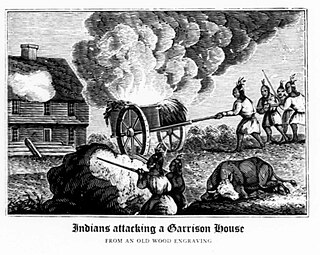
King Philip's War was an armed conflict in 1675–1678 between indigenous inhabitants of New England and New England colonists and their indigenous allies. The war is named for Metacom, the Wampanoag chief who adopted the name Philip because of the friendly relations between his father Massasoit and the Mayflower Pilgrims. The war continued in the most northern reaches of New England until the signing of the Treaty of Casco Bay in April 1678.

The Massachusett are a Native American tribe from the region in and around present-day Greater Boston in the Commonwealth of Massachusetts. The name comes from the Massachusett language term for "At the Great Hill," referring to the Blue Hills overlooking Boston Harbor from the south.
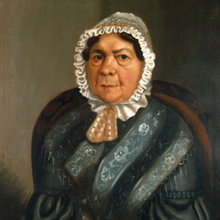
The Nipmuc or Nipmuck people are an Indigenous people of the Northeastern Woodlands, who historically spoke an Algonquin language. Their historic territory Nippenet, "the freshwater pond place," is in central Massachusetts and nearby parts of Connecticut and Rhode Island.
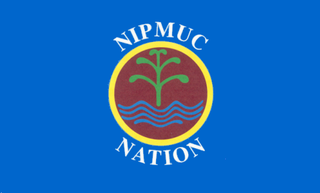
Nipmuc Nation is a state-recognized tribe of Nipmuc people, an Indigenous people of the Northeastern Woodlands based in Massachusetts.

The Pocumtuc were a Native American tribe historically inhabiting western areas Massachusetts

Praying towns were developed by the Puritans of New England from 1646 to 1675 in an effort to convert the local Native American tribes to Christianity. The Natives who moved into these towns were known as Praying Indians. Before 1674 the villages were the most ambitious experiment in converting Native Americans to Christianity in the Thirteen Colonies. John Eliot learned Massachusett and first preached to the Natives in their own language in 1646 at Nonantum, meaning "place of rejoicing." Newton developed here. This sermon led to a friendship with Waban, who became the first Native American in Massachusetts to convert to Christianity.

The Hassanamisco Nipmuc people are part of a larger tribe that identifies itself as the Nipmuc Nation. The Hassanamisco Nipmuc own three and a half acres of reservation land in what is present day Grafton, Massachusetts. This group of indigenous people is native to Central Massachusetts, Northeastern Connecticut, and parts of Rhode Island.
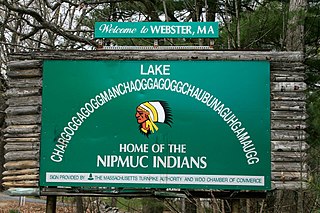
The Webster/Dudley Band of the Chaubunagungamaug Nipmuck Indians, also known as the Chaubunagungamaug, Chaubunagungamaug Nipmuck, Pegan or Dudley Indians, are a Native American tribe indigenous to the U.S. states of Massachusetts and Connecticut in the region of New England. They are one of three tribes with state recognition in Massachusetts as a tribe of Nipmuck Indians, including the Hassanamisco Nipmuc and the Natick Massachusett, although the latter are mainly descended from the Massachusett people.

The Chaubunagungamaug Reservation refers to the small parcel of land located in the town of Thompson, Connecticut, close to the border with the town of Webster, Massachusetts and within the bounds of Lake Chaubunagungamaug to the east and the French River to the west. The reservation is used by the descendants of the Nipmuck Indians of the previous reservation, c. 1682-1869, that existed in the same area, who now identify as the Webster/Dudley Band of the Chaubunagungamaug Nipmuck. Together with the Hassanamisco Nipmuc, both have received state recognition under the Massachusetts Commission on Indian Affairs.
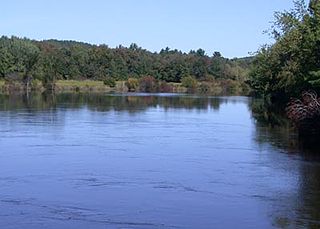
The Nashaway were a tribe of Algonquian Indians inhabiting the upstream portions of the Nashua River valley in what is now the northern half of Worcester County, Massachusetts, mainly in the vicinity of Sterling, Lancaster and other towns near Mount Wachusett. The meaning of Nashaway is "river with a pebbled bottom".

Native American tribes in Massachusetts are the Native American tribes and their reservations that existed historically and those that still exist today in what is now the Commonwealth of Massachusetts. A Narragansett term for this region is Ninnimissinuok.
More than nine variations of the name have been seen in the records throughout history. In Native American Algonquian language, Quinsigamond is loosely translated as "the pickerel fishing place." Pickerel is a type of fresh water fish commonly native to inland lakes and ponds.
Cheryll Toney Holley is the current chief of the Hassanamisco band of the Nipmuc Nation, a Native American tribe recognized by the state of Massachusetts. She was selected to succeed Chief Walter Vickers after his resignation in July 2013. As chief, Holley's duties range from spiritual advice to job placement assistance. Holley is the tribe's third female chief in the past fifty years. Furthermore, Holley is one of the five founding members of the Nipmuc Women’s Health Coalition. The coalition is run by a group of Native American women advocating for culturally appropriate health care programs for Nipmucs.

Zara Cisco Brough, often spelled as Zara Ciscoe Brough, commonly referred to as Princess White Flower, served as the Chief of the Nipmuc Native Indian Tribe for 25 years from 1962 until 1987. She is best known for her work to preserve Nipmuc heritage, especially her letter of intention to petition for federal recognition of the Nipmuc as a legally distinct Native American people, which resulted in the Nipmuc being placed on "active consideration" for the status of Federally recognized tribe by 11 July 1995.
The Massachusett dialects, as well as all the Southern New England Algonquian (SNEA) languages, could be dialects of a common SNEA language just as Danish, Swedish and Norwegian are mutually intelligible languages that essentially exist in a dialect continuum and three national standards. With the exception of Massachusett, which was adopted as the lingua franca of Christian Indian proselytes and survives in hundreds of manuscripts written by native speakers as well as several extensive missionary works and translations, most of the other SNEA languages are only known from fragmentary evidence, such as place names. Quinnipiac (Quiripey) is only attested in a rough translation of the Lord's Prayer and a bilingual catechism by the English missionary Abraham Pierson in 1658. Coweset is only attested in a handful of lexical items that bear clear dialectal variation after thorough linguistic review of Roger Williams' A Key into the Language of America and place names, but most of the languages are only known from local place names and passing mention of the Native peoples in local historical documents.
The Wunnashowatuckoog, sometimes referred to as Showatucks, were a native American tribe in Massachusetts who lived in southern Worcester County, Massachusetts. The name of the tribe, translating to 'people at the fork of the river', alludes to them residing on the Blackstone River. They were known to cohabitate with the Monashackotoog.
The Praying Indians of Natick were a community of Indigenous Christian converts, known as Praying Indians, in the town of Natick, Massachusetts, one of many Praying Towns. They were also known as Natick Indians.
References
- ↑ Ricky, Donald (1998). Encyclopedia of Massachusetts Indians. Somerset Publishers, Inc. ISBN 978-0-403-09330-4 . Retrieved 13 December 2020.
- ↑ Sultzman, Lee. "Nipmuc History". First Nations: Issues of Consequence. Retrieved 13 December 2020.